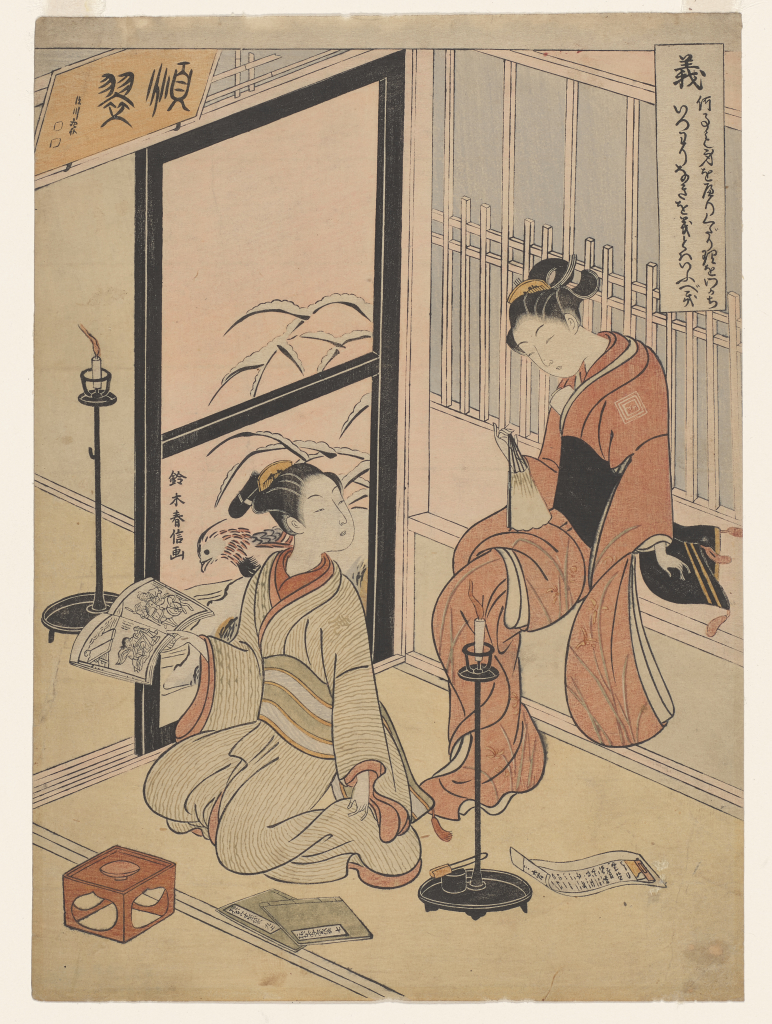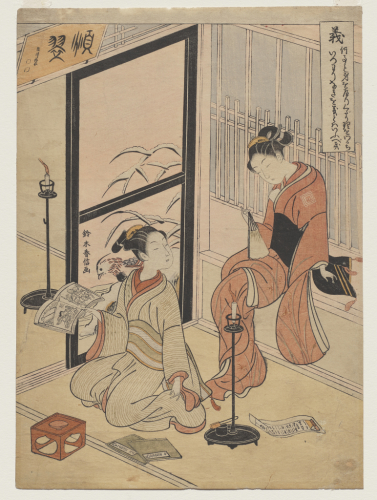Gi (Righteousness), from the series Gojō (The Five Confucian Virtues)

Suzuki Harunobu, Gi (Righteousness), from the series Gojō (The Five Confucian Virtues), 1767, color woodblock print with embossing on paper; chūban nishiki-e, Bequest of Winslow B. Ayer, public domain, 35.39

This work is not currently on view.
- Title
Gi (Righteousness), from the series Gojō (The Five Confucian Virtues)
- Related Titles
alternate; translated: Rectitude
original language: 義
series (original language): 五常
series (translated): The Five Confucian Virtues
series (transliterated): Gojō
translated: Righteousness
transliterated: Gi
- Artist
- Date
1767
- Period
Japan: Edo period (1615-1868)
- Medium
color woodblock print with embossing on paper; chūban nishiki-e
- State
first state
- Catalogue Raisonné
Chiba 2002, 166; Waterhouse 2013, 186-193
- Dimensions (H x W x D)
image: 10 7/8 in x 8 1/16 in; sheet: 11 3/8 in x 8 1/16 in
- Inscriptions & Markings
inscription: 順翠 // 深川親和, printed, upper left [on gaku calligraphy board] Transliteration (Translation): jun-yoku [or jun-sui; see notes] // Fukagawa Shinna (in accordance with what is next [perhaps several puns intended here; see notes] // Fukagawa Shinna [aka Mitsui Shinna, 1700-1782, a popular calligrapher in Edo]) Language: Japanese Description: See David Waterhouse, The Harunobu Decade (Leiden: Brill, 2013), 1:262 for discussion of possible readings and English translations of signboard text.
signature: 鈴木春信画, printed, center left Transliteration (Translation): Suzuki Harunobu ga (picture [by] Suzuki Harunobu) Language: Japanese
title; inscription: 義 / 何事も身をへりくだり理をわかち // いつわりなきを義とハいふべき, printed within rectangular cartouche, upper right Transliteration (Translation): Gi / Nanigoto mo mi o herikudari ri o wakachi // itsuwari naki o gi to wa iubeki (Rectitude: In all things to be humble, discern the path of reason, and abstain from falsehood--this is what we call rectitude) Language: Japanese
- Collection Area
Asian Art; Graphic Arts
- Category
Prints
Japanese Traditional Prints
- Object Type
relief print
- Culture
Japanese
- Credit Line
Bequest of Winslow B. Ayer
- Accession Number
35.39
- Copyright
public domain
- Terms
This print is one of five to illustrate poems associated with traditional virtues of Confucian ideology. The setting here is probably a brothel that specialized in male prostitutes. The elegantly attired figures are looking at picture books by candlelight. Although the poems in the series seem to have been written in a rather serious vein, the two young men seem to be simply passing the time. A sake cup sits on a stand, and the book—open to a scene of a famously morally righteous warrior—is a well-known drawing manual, Tachibana Morikuni's Illustrated Book of the Treasure-Bag of Sketches (1720).
Blind-embossing enhances the stems of the irises of the right-hand figure's robe as well as the white snow piled on the reeds of the painted screen.
- Exhibitions
2011 The Artist's Touch, The Craftsman's Hand: Three Centuries of Japanese Prints from the Portland Art Museum Portland Art Museum
2018 Suzuki Harunobu and the Culture of Color Portland Art Museum









